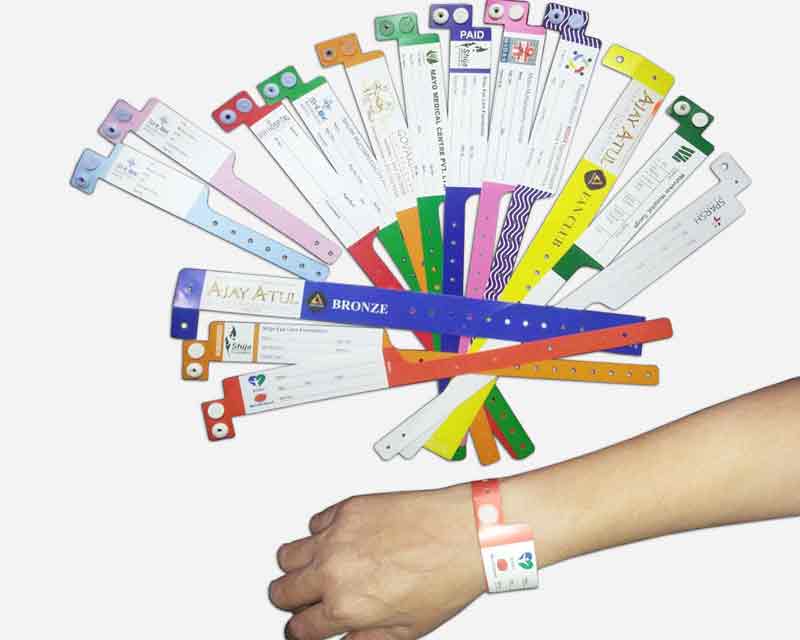Why a Patient Identification Band is Essential in High-Volume Environments like Emergency Rooms
Why a Patient Identification Band is Essential in High-Volume Environments like Emergency Rooms
Blog Article
Exploring the Different Kinds Of Patient Identification Band Used in Medical Facilities
In the detailed globe of medical care, the important duty of Patient Identification bands typically goes undetected. These bands, differing from basic paper wristbands to sophisticated RFID bands, create the backbone of Patient safety protocols, making sure accuracy in Patient Identification.
Understanding the Significance of Patient Identification Bands
While they may appear like plain devices, Patient Identification bands play a crucial function in medical facilities. These bands act as a crucial device for verifying Patient identity, avoiding medical errors related to misidentification. The bands usually show vital info such as the Patient's name, age, blood type, and any kind of recognized allergic reactions. They permit healthcare experts to promptly access this vital information, therefore facilitating prompt and exact medical therapy. Patient Identification bands likewise help in improving administrative tasks, guaranteeing exact record-keeping and invoicing. Despite their simplicity, these bands symbolize the concept of Patient security, a cornerstone of high quality health care. Without them, the risk of clinical errors, and subsequently, Patient damage, might dramatically raise.
Conventional Paper Wristbands: Their Use and Limitations
Conventional paper wristbands have been a staple in Patient Identification across numerous clinical centers. While their usage prevails, they harbor specific restrictions that might influence their effectiveness in Patient management. This area will concentrate on the scope of their application and the integral downsides related to their usage.
Paper Wristbands: Usage Scope
In the realm of Patient Identification, paper wristbands have actually long held a vital role. These bands are typically used in outpatient settings, where the Patient's remain is momentary. The wristbands consist of necessary info such as the Patient's name, day of birth, and a special Identification number. This basic, yet efficient system, enables doctor to rapidly and precisely identify individuals, making sure the right therapy is administered. Paper wristbands are also used in emergency scenarios, where rapid Identification is critical. Their usage includes events like blood contribution drives and mass vaccination programs, even more stressing their flexibility. In spite of advancements in innovation, the modest paper wristband remains a trustworthy and cost-effective solution for Patient Identification in different medical care situations.
Limitations of Paper Wristbands
In spite of their extensive use, paper wristbands are not without their disadvantages. In enhancement, paper wristbands usually do not have the technological capacities of even more modern alternatives, such as barcoding or RFID chips, restricting their functionality to just showing written details. Paper wristbands can create discomfort or skin irritability to some clients, particularly when put on for extensive periods.
Barcoded Wristbands: Innovations in Patient Identification
While Patient Identification has actually long been an essential aspect of medical care, the introduction of barcoded wristbands signifies a considerable jump forward. These bands take advantage of the simplicity of barcoding innovation, enabling Patient details to be quickly scanned and accessed. They improve the speed and precision of Patient Identification, lowering the risk of clinical mistakes connected to misidentification. Barcoded wristbands are affordable, very easy to generate, and eliminate handwriting mistakes common with manual systems. They are not without limitations. While they use enhancements over typical bands, the barcode can become smudged or worn, making it unreadable. In spite of this, barcoded wristbands stay an essential tool in contemporary health care setups, representing the crossway of modern technology and Patient treatment.
Radio Regularity Identification (RFID) Bands: an Action In The Direction Of Futuristic Health Care
The development of Patient Identification bands has actually caused the appearance of Radio Regularity Identification (RFID) Bands (patient identification band). These ingenious devices present vital benefits for healthcare facilities, offering an extra efficient and highly progressed ways of Patient Identification. The implementation of RFID in healthcare is a significant step towards an extra advanced approach to Patient administration and safety
Understanding RFID Bands

RFID Bands: Secret Advantages
Embracing a future where modern technology and medical care combine, radio frequency Identification bands offer numerous vital benefits. Mostly, these bands enhance Patient safety by providing accurate, rapid Identification, consequently lowering medical errors. RFID bands can store a substantial quantity of Patient data, including clinical background and allergies, allowing individualized care. They also enhance management jobs, as the automated data access replaces manual processes, improving efficiency and decreasing paperwork. RFID bands provide real-time monitoring of clients, essential in high-risk settings such as surgery or intensive care. These bands are resilient and resistant to ecological variables, making sure consistent performance. In general, RFID bands stand for a significant improvement in Patient Identification innovation, profiting both patients and medical care suppliers.
Executing RFID in Medical Care
As we enter a technically innovative age, the execution of RFID bands in health care becomes progressively important. These bands give a smooth means to track and recognize clients, guaranteeing their safety and enhancing performance in treatment procedures. RFID bands use countless benefits over typical Identification approaches. They can store a vast quantity of data, consisting of the Patient's medical history and treatment plans, which can be quickly accessed by health care companies. This information aids medical professionals make educated choices regarding the Patient's treatment strategy. Furthermore, RFID bands lower medical mistakes by supplying precise Patient Identification, which is crucial in protecting against misdiagnosis or incorrect medication administration. Hence, the execution of RFID bands is a considerable action in the direction of enhancing Patient safety and security and healthcare shipment.

Color-Coded Wristbands: Assisting in Quick and Accurate Medical Diagnosis
In the busy environment of a clinical facility, color-coded wristbands have become essential devices for swift and exact Identification of an individual's clinical condition. These wristbands, put on by people, lug details shades that correspond to various clinical conditions or standings. For example, red could suggest allergic reaction threats, while yellow could symbolize an autumn threat. This system is designed to provide instant aesthetic signs to medical care suppliers, enhancing Patient safety and security and care high quality. In emergency situations, the usage of these wristbands enables for quick decision-making. The effectiveness of color-coded wristbands depends on the harmony of shade analysis across healthcare institutions, calling for usual criteria for consistent application.
Approaches for Reliable Implementation and Administration of Patient ID Bands
Achieving optimum use of Patient Identification bands necessitates a well-structured approach for their application and management. Patient education is additionally important; clients have to comprehend the purpose of the bands and the requirement for their constant wear. It's essential to have a back-up plan in location, such as barcode scanning or biometrics, to ensure that Patient Identification is never endangered.
Final thought
Patient Identification bands are essential in medical centers to make sure safety and precision. Traditional paper, barcoded, RFID, and color-coded wristbands each hold special advantages, varying from cost-effectiveness to advanced information storage and immediate clinical notifies. Reliable application and monitoring of these bands can dramatically decrease clinical errors, Visit Your URL boost performance, and enhance total Patient treatment. Thus, understanding and utilizing these Identification tools is extremely important for keeping high criteria in healthcare.
These bands, differing from easy paper wristbands to innovative RFID bands, form the foundation of Patient safety and security methods, making sure precision in Patient Identification.The development of Patient Identification bands has brought regarding the appearance of Radio Frequency Identification (RFID) Bands. In general, RFID bands represent a considerable innovation in Patient Identification technology, profiting both patients and health care carriers.
RFID bands reduce clinical mistakes visite site by giving exact Patient Identification, which is crucial in avoiding misdiagnosis or incorrect medicine management. Patient education and learning is additionally crucial; patients need to recognize the purpose of the bands and the requirement for their constant wear.
Report this page